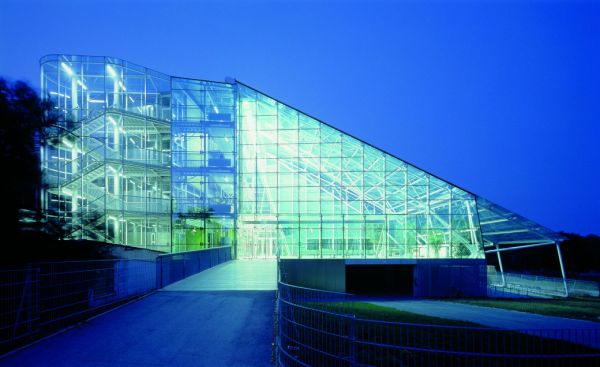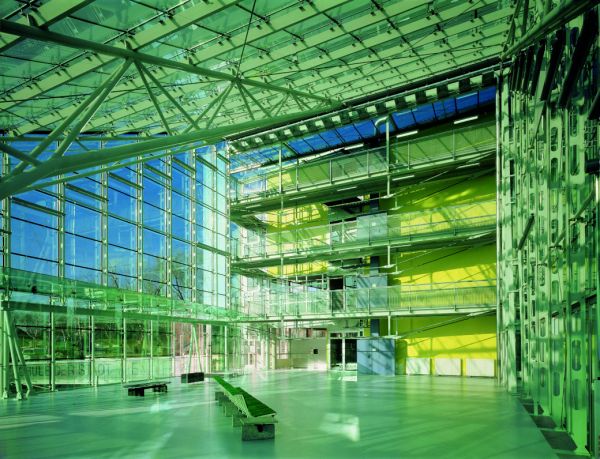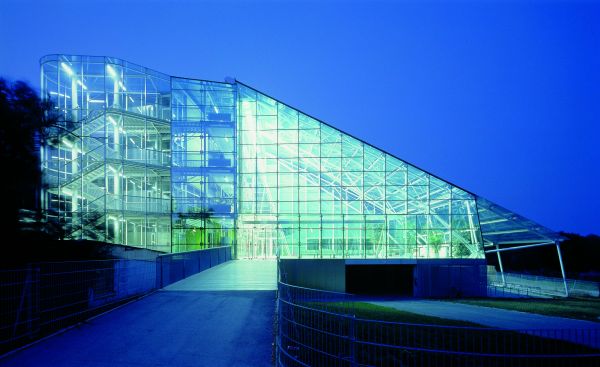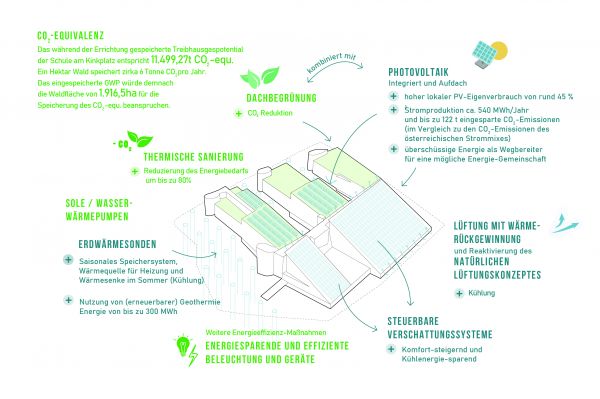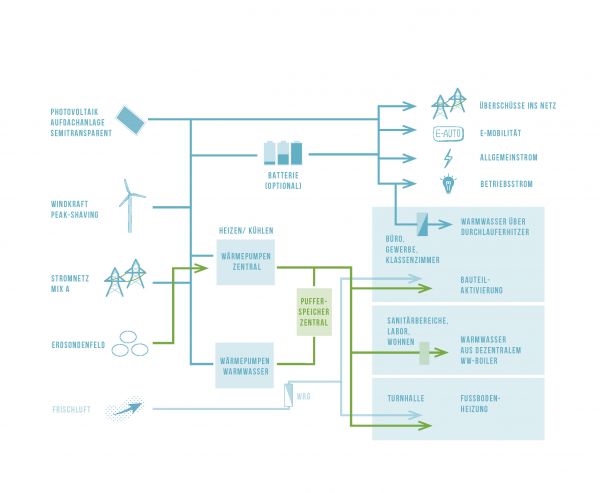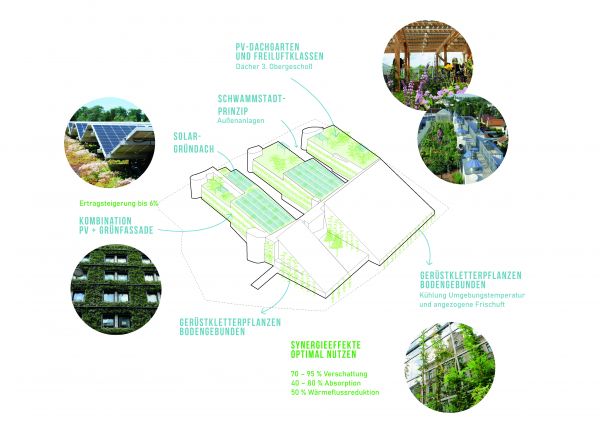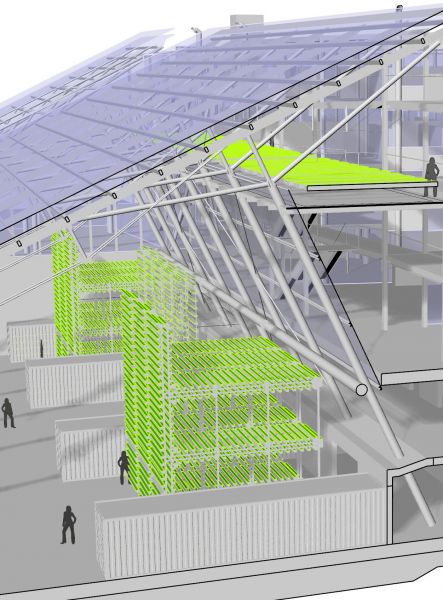GreenTech-Renovation - Energetic Renovation of Glass Buildings of Architectural Value
Short Description
Abstract
The focus of the GreenTech-Renovation project is to find innovative solutions for the energetic refurbishment of architecturally valuable buildings with a high proportion of glass. To achieve this, a forward-looking building physics concept is to be developed that includes the use of alternative forms of energy. An intelligent usage concept could strengthen the energetic renovation concepts with ecological and social commitment and guarantee their sustainability. The "10 Rs" of the circular economy serve as a guideline.
Motivation and Research Questions
- How can architecturally valuable buildings with a high proportion of glass be energetically renovated?
- How can the energy consumption of existing buildings with a high proportion of glass be reduced?
- How can renewable energy sources be developed and used in existing buildings?
Initial Situation/Status Quo
Climate policy sees an urgent need for the energy-efficient refurbishment of existing buildings. Buildings with architectural value that are already under monument protection or worthy of being listed pose a particular challenge. They are part of our cultural heritage and therefore deserve special attention during renovation, regardless of their protection status. Helmut Richter's School on Kinkplatz is to serve as a demonstration project for this research work, as many issues relating to sensible, energy-saving renovation can be exemplary addressed through this structure. Buildings with a high proportion of glass consume more energy all year round and are rarely connected to renewable energy sources. They thus have an above-average share of CO2 emissions and energy consumption.
Project Content and Objectives
The focus of the research is on finding innovative solutions for the energetic, ecological and social revitalization of architecturally valuable buildings with a high proportion of glass.
Cross-links to current initiatives at the European level were to be established, since the exploratory project in question fulfills the relevant criteria on several levels. In the GreenTech-Renovation project, the topics of CO2 reduction, circular economy, the renovation of an outstanding, sophisticated building, adapted usage concept, innovation, the use of renewable energy, building greening and user integration are all dealt with. The goal was to develop different solution concepts for the fulfillment of the posed task and to evaluate them. The concepts are to cover a broad spectrum and pursue innovative approaches. The transferability of the strategies and solutions for reducing energy consumption and CO2 emissions are to increase their reach and impact.
Methodical Approach
Based on the detailed analysis, the measures for the demonstration object were continuously developed. Utilization concepts in five scenarios were taken into consideration. The energy concept with the use of renewable energy sources was developed in close cooperation between the energy experts, building physicists and architects to provide visible measures in the appropriate places and with the corresponding methods.
The involvement of experts and research institutions from the fields of renewable energy, glass technology, photovoltaics and building research enabled international exchange and knowledge of comparable projects in Europe, of state-of-the-science solutions and those being researched or under development there, as well as new technologies that could be applied in the energetic refurbishment of glass buildings. Considering synergetic measures such as building greening makes a further CO2 reduction, a cost-neutral increase in comfort and the support of energy production possible.
Results and Conclusions
From the outset, interdisciplinary and transdisciplinary cooperation has shown that in the present and in the future, when it comes to the demanding tasks associated with energy-efficient building refurbishment, planning must no longer be linear, but circular. In the circular working method, the building stock is first analyzed in detail; the refurbishment goals are flexibly adapted to the findings to minimize the effort, material usage, energy consumption and CO2 emissions, to maximize the use of renewable energy and to preserve the integrity of the building stock as best as possible. The result is a concept that, with the interaction of all measures, i.e., thermal renovation, the use of renewable energy sources (PV and BIPV, geothermal probes), CO2 neutrality and a positive balance in electricity production, makes an architecturally valuable building with formerly high energy requirements and comfort deficits into a lighthouse project with good usability and a pleasant indoor climate. The conclusion, therefore, is that this planning method must become standard in order to cope with the energy transition and the increase in the renovation rate from the current 1.5% to at least 3%. The currently high costs for energy, material and wages, as well as the shortage of skilled workers, encourage renovation methods that require more effort in the analysis and concept phase and thus use reduced construction measures in a targeted and effective manner.
Outlook
The assumption made at the time of the application that the energetic refurbishment of buildings with a high proportion of glass will be an issue that needs to be urgently addressed has become even more true due to the enormous rise in energy costs. In combination with the goals set in the EU for CO2 neutrality and the principles of the circular economy, the procedure of preserving the built stock, even in difficult starting situations for renovation and subsequent use, is clearly confirmed. The involvement of international experts and research institutions has shown that the topic of GreenTech-Renovation is also relevant worldwide and that exemplary, transferrable solutions are needed. Replicable solutions, e.g., in modular design, are increasingly in demand and suitable building blocks are necessary. Increased material and energy costs will accelerate the mainstreaming of circular economy principles. Therefore, the individual, transferrable measures developed in GreenTech-Renovation can be applied to different cases. The international network for dissemination and replication required for this was already available in the team, was consolidated and extended during the research work and is currently being and will be further expanded in the future.
Project Images
Terms of use: The pictures listed underneath the header “Project Pictures” originate from the projects in the frame of the programmes City of Tomorrow, Building of Tomorrow and the IEA Research Cooperation. They may be used credited for non-commercial purposes under the Creative Commons License Attribution-NonCommercial (CC BY-NC).
Project Partners
Project management
Architects Tillner & Willinger ZT GmbH
Project or cooperation partners
- IBO - Österreichisches Institut für Bauen und Ökologie GmbH
- Vienna University of Technology, research area for Structural Design and Timber Engineering
- University of Applied Sciences Technikum Wien, competence field for Renewable Energy Systems
- GRÜNSTATTGRAU Forschungs- and Innovations GmbH
- vertical farm institute
- École Polytechnique Fédérale de Lausanne (EPFL), Laboratory of Techniques and Preservation of Modern Architecture
- Hubmann Vass Architects
Contact Address
Architekten Tillner & Willinger ZT GmbH
Margaretenplatz 7/2/1
A-1050 Wien
Tel.: +43 (1) 310 68 59
E-mail: tw@tw-arch.at
Web: www.tw-arch.at

